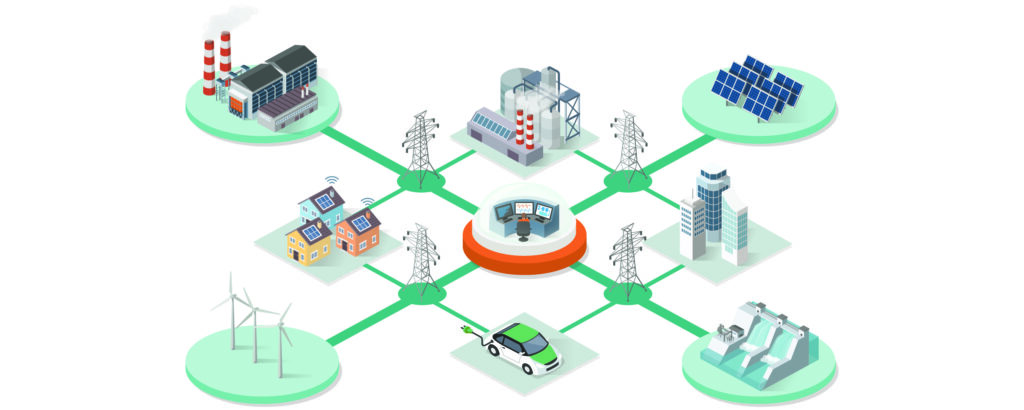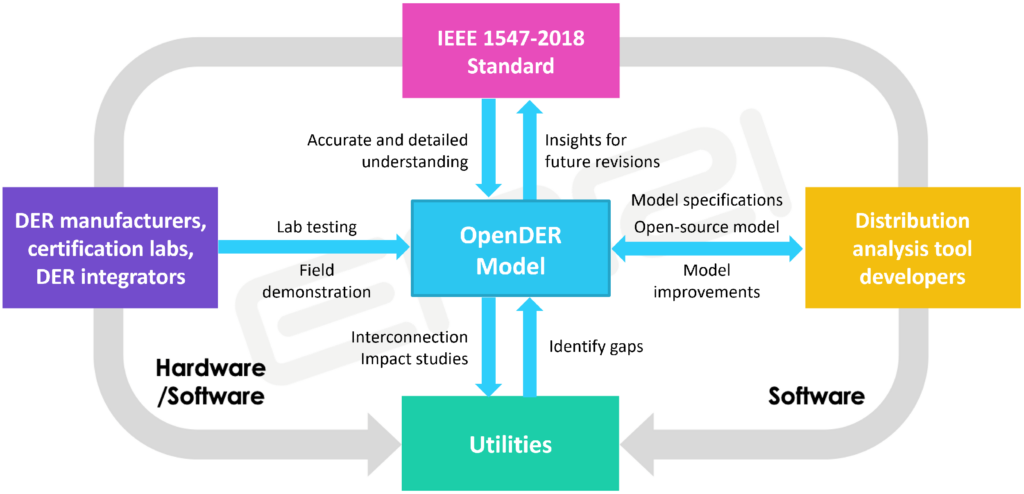Tags: Grid support, interconnection, OpenDER
EPRI’s publicly available OpenDER model aims to ensure accurate interconnection and planning studies
Distributed energy resources (DER) are being added to the power system at a rapidly accelerating pace. In the U.S., for example, the electric power sector was operating around 74 gigawatts of solar photovoltaics at the end of 2022, which was approximately three times the capacity in operation at the end of 2017.
According to the U.S. Energy Information Administration (EIA), a combination of declining construction costs and favorable tax credits will add another 63 gigawatts of solar by the end of 2024. The recently passed Inflation Reduction Act (IRA), which provides long-term financial incentives for purchasing many DERs, is expected to spur even faster market growth. By 2030, for instance, 13 percent of U.S. homes are expected to have solar.
This influx of DERs is no accident. In addition to the federal government supporting investments in low or zero-carbon DERs through tax and other incentives, the current administration set a goal of fully decarbonizing the U.S. power sector by 2035. And at the local level, 25 states plus the District of Columbia have established economy-wide greenhouse gas emission reduction targets. Corporations, too, have also set ambitious decarbonization goals. Globally, nearly 400 corporations in industries ranging from manufacturing and retail to hospitality and services have committed to achieving 100 percent renewable electricity.
“If you look at the objectives society is trying to achieve with renewable generation sources and moving towards equitable access to renewables to lower carbon emissions, DER plays a big role,” said Dr. Aminul Huque. Huque is an EPRI program manager who manages smart inverter and grid support technology research that aims to improve renewables’ safe and reliable integration on the power grid. “A lot of the new systems are connected on the distribution side, which is fundamentally changing how the power system is planned and operated.”
The Importance of DER Grid Support
Even though the power system is changing to incorporate more DERs, utilities and grid operators are still responsible for maintaining the same (and eventually better) power quality and stability levels as they have historically. Put simply, residential and commercial electricity customers—and society as a whole—expect the decentralized and decarbonized power system to be every bit as reliable as the one that relied on large, central station power plants. It’s a high bar: The National Academy of Engineering ranked electrification as the greatest engineering achievement of the 20th century, surpassing spacecraft, the Internet and computers, and agricultural mechanization.
For the emerging power system to meet reliability and power quality expectations, DERs must provide grid support. For instance, DERs must be able to provide voltage support. “There are a group of active and reactive power-based smart inverter functions that are meant for grid voltage support,” Huque said.
For example, smart inverters provide volt-var and volt-watt controls to ensure the distribution system doesn’t experience voltage limit violations or excessive variation. DERs connected to the power system must also be able to continue operating (also known as ride-through) during a momentary voltage or frequency disturbance.
“In the past, if you had a disturbance, you wanted the DER to disconnect,” said Yiwei Ma, an EPRI engineer in the DER integration research area. “That is not acceptable any longer. Now, if you have a disturbance for a few seconds and then everything is fine, you don’t want millions of DERs to shut down.” DERs also need to support the grid by increasing or decreasing their power when the power system’s frequency fluctuates, a function known as frequency watt or frequency droop.
An Important Standard Emerges
For years, the industry has been developing standards that ensure that DERs interconnecting to the grid meet specific requirements. That process began in 2003 with the release of IEEE Standard 1547. The standard has since evolved, with amendments in 2014 and recently in 2018, when a new edition of IEEE 1547 was published.
IEEE 1547-2018 has several significant additions and modifications, many of which are designed to ensure that DERs can provide grid-support functions like volt-var control and ride-through capabilities. Even before IEEE 1547-2018 was rolled out, states like Hawaii and California—both of which have seen significant DER growth sooner than other states—began requiring grid-support functions for DER interconnections.
Today, utilities and public utility commissions (PUCs) across the country are preparing to mandate that new DERs being interconnected comply with IEEE 1547-2018 and meet appropriate certification standards, like UL 1741SB. “As the certified inverters are starting to become available in the market, utilities are getting ready to make the new standard mandatory this year,” Huque said.
The rollout of the latest version of the standard also significantly impacts what utilities need to consider in their DER interconnection studies. These studies examine whether the approval of DER interconnecting at a specific grid location will negatively impact the power system. For very small DER, the analysis is quick and streamlined. But for larger DERs, more in-depth modeling and analysis are required.
When a potential negative impact is identified, interconnection studies also present possible solutions to solve the problem. In some instances, the solutions to address negative system impacts can be expensive, like reconductoring, changing the protection devices in place, or even swapping out transformers to allow for interconnection. These higher costs are then passed on to the DER owner. The stakes of interconnection studies, then, are very high. “The study determines if there is a problem or not,” Ma said. “If there is a problem, it also determines the solution and the cost of the solution. That is why these studies are critical and why their accuracy is so important.”
Ensuring Models Accurately Represent DER Grid Support Capabilities
But here’s the challenge: Manufacturers, utilities, researchers, consultants, and software developers used to conduct DER interconnection studies need to understand and utilize the IEEE 1547-2018 requirements accurately. After all, interconnecting DER with appropriate grid support capabilities that alleviate potential grid problems can be far cheaper and quicker than infrastructure upgrades.
The only way to know that is for all stakeholders to interpret the standard uniformly. “Our vision is to ensure across the industry that utilities and product and software developers who are all pointing to this standard aren’t working in silos,” Huque said. “We want to make sure they are interpreting the standards in the way they were developed or agree to the interpretation if something is not clear. That way, when simulation tool vendors develop or update models, the behavior assumed in the simulations and studies will match how actual products behave in the field.”
Past EPRI research highlighted inconsistencies in the models the industry relied on. More specifically, the model verification work examined whether existing models complied with the IEEE standard. Gaps and missing features that may impact the accuracy of the interconnection studies were identified.
To drive the consistency necessary for accurate DER interconnection and planning studies, EPRI recently released an open-source distributed energy resource model known as OpenDER. At its core, the OpenDER model represents the functional definitions and requirements of IEEE 1547-2018 to analyze both the dynamic and steady-state behaviors of DERs. The release includes the OpenDER model software implemented in Python programming language that utilities and other stakeholders can use immediately. EPRI also released a document with the model’s underlying specifications and equations.
“Through this work, we are providing a detailed model specification that any software developer or consultant, or academic can review and implement in their own model. Or they can use our whole model or part of it,” Ma said. “Regardless of what they use, we want to make sure that utilities, software developers, consultants, and others have a model that correctly represents the products that are being designed and certified following IEEE 1547-2018.”
Leveraging Research Expertise and Understanding of the Standard
As a key contributor to the development of the IEEE 1547-2018 standard and with a legacy of experience testing smart inverters in the laboratory and field, EPRI is well suited to lead the development of an open-source DER model and bring together stakeholders to build consensus.
As part of the development of OpenDER, EPRI has also conducted lab tests of inverters certified to IEEE 1547-2018 to validate that the model accurately reflects product behavior. “Because of our prior industry engagement to define smart inverter function definitions and our continued involvement in the standard development, coupled with years of field demonstrations, we are in a position to help the industry with a model that can be used as a benchmark or as an actual model,” Huque said. “In collaboration with the industry, we want to make this model the gold standard.”
That is also why EPRI launched the DER Model User’s Group (DERMUG) soon after OpenDER was released. Just as the model itself was designed to unify and harmonize the understanding of IEEE 1547-2018, the user group provides a forum for stakeholders that may not normally interact to share feedback and insights about OpenDER and about the interpretation of the standard. The learnings will also be used for the next standard revision, which began in January.
Introductory DERMUG meetings attracted hundreds of participants who wanted to learn more about the OpenDER model. Since then, DERMUG has hosted meetings every two weeks to solicit industry feedback on the model’s details and to communicate potential improvements.
“We are already making improvements to the model,” Huque said. “We have a version one of the models done and reviewed by the user group, and we plan to release version two early in 2023. Moving forward, we will continue to take user group feedback and lab test results until we are confident that we have done everything possible to ensure the model is accurate.”
Ultimately, the real value of OpenDER is to ensure that all the models used for interconnection and planning studies can accurately represent the power system impacts of IEEE 1547-2018 compliant DERs. “This will ensure all the studies are done according to the standard and the products being tested so that whatever impact we are seeing is correct and whatever solution we come up with using grid support matches the actual product,” Huque said. “Hopefully, that will help have more efficient interconnection and sometimes reduce the cost and time of interconnection.”
EPRI Technical Experts:
Aminul Huque, Yiwei Ma
For more information, contact techexpert@eprijournal.com.
Additional Resources:
- OpenDER homepage
- IEEE 1547-2018 Open Source DER (OpenDER) Model: Version 2.0
- OpenDER model repository on GitHub
- Verification of DER Models in Commercial Distribution Planning Tools: Synergi 6.16.0
- Verification of DER Models in Commercial Distribution Planning Tools: CYME 9.2.2
- Distributed Energy Resource Model Verification Framework: Second Edition



